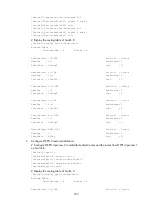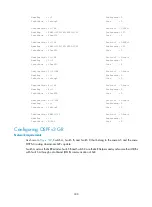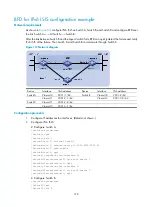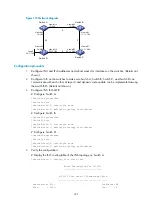
311
Step Command
Remarks
11.
Specify the maximum
number of equal-cost load
balanced routes.
ipv6 maximum load-balancing
number
Optional.
8 by default.
NOTE:
The
ipv6 filter-policy export
command is usually combined with the
ipv6 import-route
command. If no
protocol is specified for the
ipv6 filter-policy export
command, routes redistributed from all routing
protocols are filtered before advertisement. If a protocol is specified, only routes redistributed from the
routing protocol are filtered for advertisement.
Configuring BFD for IPv6 IS-IS
Bidirectional forwarding detection (BFD) provides a mechanism to quickly detect the connectivity of links
between IPv6 IS-IS neighbors, thus to improve the convergence speed of IPv6 IS-IS. For more information
about BFD, see
High Availability Configuration Guide
.
To configure BFD for IPv6 IS-IS:
Step Command
Remarks
1.
Enter system view.
system-view
N/A
2.
Enable an IS-IS process and
enter IS-IS view.
isis
[
process-id
]
N/A
3.
Configure the network entity
title for the IS-IS process.
network-entity
net
Not configured by default.
4.
Enable IPv6 for the IS-IS
process.
ipv6 enable
Disabled by default.
5.
Return to system view.
quit
N/A
6.
Enter interface view.
interface
interface-type
interface-number
N/A
7.
Enable IPv6 for an IS-IS
process on the interface.
isis ipv6 enable
[
process-id
]
Disabled by default.
8.
Enable BFD on the interface.
isis ipv6 bfd enable
Not enabled by default.
Configuring IPv6 IS-IS MTR
Configuration guidelines
On a network comprising both IPv4 and IPv6 topologies, the IPv4 and IPv6 topologies must be consistent
so that both IPv6 IS-IS and IPv4 IS-IS can use the Shortest Path First (SPF) algorithm to perform route
calculation. If they are different, routers supporting both IPv4 and IPv6 send IPv6 packets to routers that
do not support IPv6, and thus packet loss occurs.
To solve the problem, you can configure IPv6 IS-IS Multi-Topology Routing (MTR) to perform route
calculation separately in IPv4 and IPv6 topologies.
















































